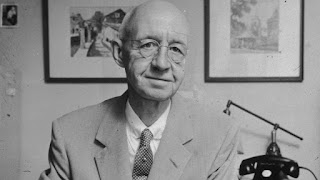"Anyone
who attempts anything original in this world must expect a bit of
ridicule."
Clarence
Birdseye was obsessed with food. He would eat anything. "Scrumptious"
was how he described lynx marinated in sherry. He sampled seal meat, owl, polar
bear, filleted rattlesnake sizzled in pork fat, hawk, porcupine (de-quilled, presumably) and skunk (but mercifully
only its front half).
He
even made a string-powered gizmo to catch starlings in the yard of his
Massachusetts home. Whether the device's purpose was to rid him of pests, provide
dinner, or both is lost to history.
The editor of his college yearbook
teased him by putting this phony quote by his photo: “I ain’t afeer’d o’bugs, or toads, or worms, or snakes, or
mice, or anything.” Indeed, when he
was 10, he wondered if there might be a market for muskrat. It turned out there
was, and with the proceeds from the beasts he trapped and sold, he bought a
shotgun.
4,495 Ticks
His
college nickname was "Bugs." This turned out to be prescient. His
family's financial woes forced him to drop out. Soon he found work as a
naturalist out west. He helped researchers study Rocky Mounted Spotted Fever
and was at liberty to kill any animal that might be carrying the creepy
creatures. He shot more than 1,000 deer, elks, mules, and mountain sheep, as a
result, collected precisely 4,495 ticks. To his credit, his report did much to
advance medical and scientific knowledge about the disease.
Later
he bred foxes for their fur. This led him to Labrador where he saw something
that would change his life. He watched the
Inuit ice fishing. When they yanked fish from the ocean, the 30-degree-below zero
air made them freeze rock solid almost before they hit the ground. Then, wonder
of wonders, when the fish thawed, they tasted fresh.
Frozen
food already existed, but no one had mastered the process of chilling the edibles, getting them to market, and then keeping them below freezing in stores. Existing frozen food was so
appallingly bad not even prison inmates would eat it. Wanting to ward off
riots, New York state banned it in its penitentiaries. Stores selling frozen
food had to display signs in their windows that resembled warning labels.
Starting
around 1915 Birdseye started to experiment, first with cabbage and then with
caribou in sea water and ice. In 1922 an ice cream company gave him permission
to run experiments in its plant. The next year Birdseye started his own
company.
To
simplify production, he decided to sell his frozen foods in uniformly-sized
small rectangular boxes. Then he had to master multiple challenges. He perfected
waterproof inks. He devised glues that would withstand freezing. He conjured up
filleting machines, and he designed wrappers. (He persistence led DuPont to
invent cellophane.)
Frozen Into Tidy Blocks
The
key to his manufacturing process lay in his invention of the "multiplate
freezing machine." It compressed whatever was being frozen into tidy
blocks, thus preventing germs from entering and making the shipping easier.
As
clever as Birdseye was, no one wanted to buy his food. Railroads shunned his
wares fearing they'd make a mess. Sanitation officials, wary of
disease-carrying food, didn't like the idea. Stores had no freezers, and
shoppers were no different from prison convicts. They also loathed all things
frozen whether they were haddock or green peas.
Enter
Marjorie Merriweather Post, the grand dame of The Post Company, famed for its
many breakfast cereals. Legend has it that when her yacht sailed into
Gloucester where Birdeye had his factory, her cook served her goose for dinner.
It wasn't just any goose. He had bought one of Birdseye's frozen birds at the
market.
She
loved it, and after nagging her father for three years, she got him to buy Birdseye's
company for the then fantastic sum of $22 million. The truth is that she was
smart as a whip and, goose or no goose, saw a smart business move and made the
deal happen all by her female self.
“A Scientific Miracle”
Birdseye
went to work for Post and lived happily and wealthily ever after. Its financial
wherewithal created the infrastructure that allowed the industry to grow. Post
gave grocery stores display freezers. It taught clerks how to use them and sell
the chilly food. It sold grocers frozen food on consignment to minimize their
risk. Lavish advertising promised housewives the best of summer's luscious
fruits in winter. Stamping its good journalism seal of approval, The New York
Times raved in 1932 that frozen food was "a scientific miracle in home
management."
"Change,"
said Birdseye, "is the very essence of American life." What he
neglected to add was that to make that change happen it takes someone with the courage
to defrost old-fashioned thinking.
Buy the book "Courage 101: True Tales of Grit & Glory" at Amazon!
MORAL: In a crisis, don't freeze.
Buy the book "Courage 101: True Tales of Grit & Glory" at Amazon!



No comments:
Post a Comment